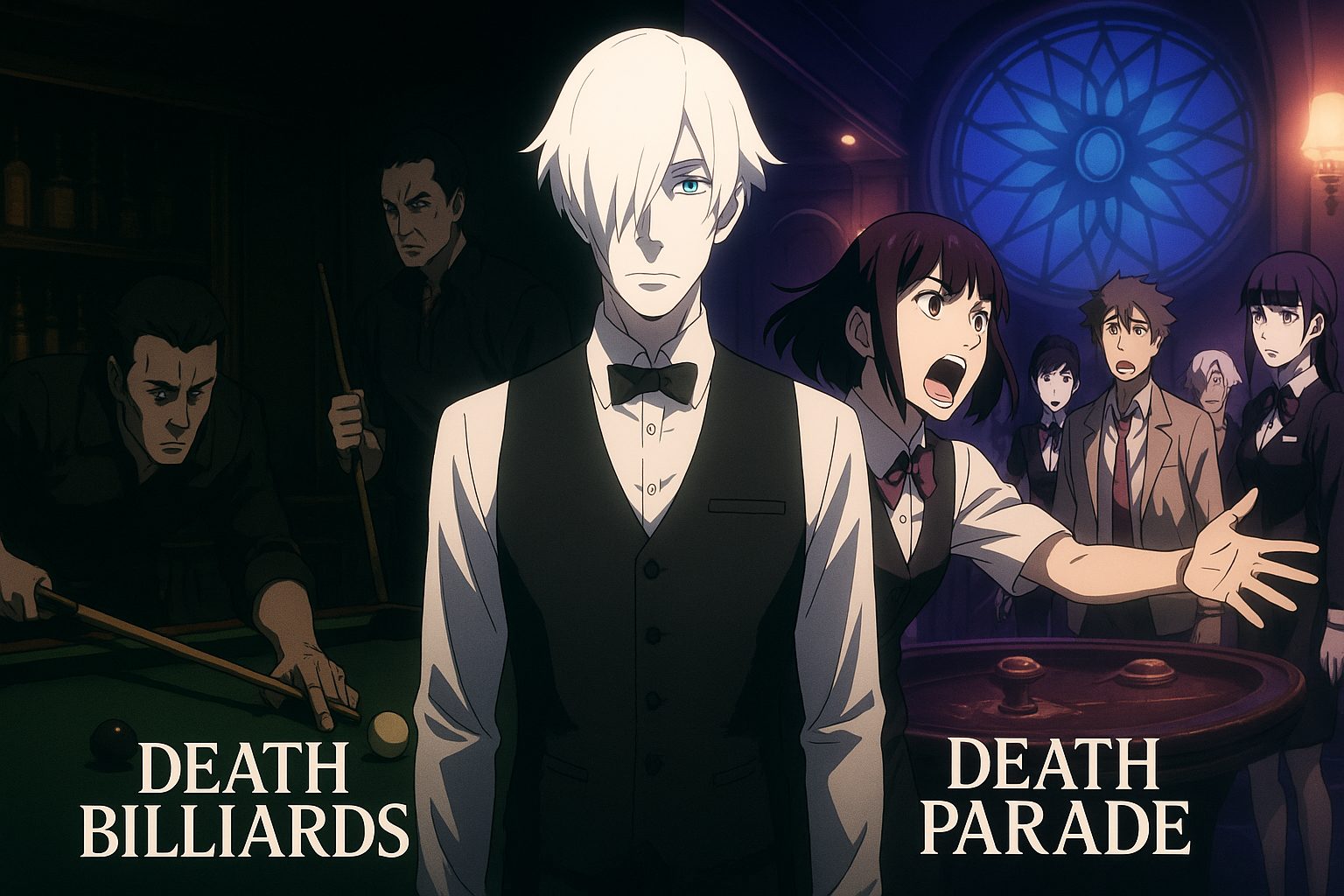Introduction: Two Stories, One World
At first glance, Death Billiards and Death Parade may seem like two versions of the same idea—and in many ways, they are. Both take place in the mysterious afterlife bar known as Quindecim. Both feature a bartender named Decim who judges the souls of the dead. And both explore the murky space between morality, memory, and the meaning of judgment.
But dig a little deeper, and you’ll find that these two titles aren’t merely connected—they’re conceptually distinct.
One is a quiet experiment in character-driven tension. The other is a sprawling emotional journey about what it means to be human.
So, how exactly do Death Billiards and Death Parade differ? And what makes watching both a richer experience? Let’s break it down.
What Connects Death Billiards and Death Parade?
While they were released two years apart (Death Billiards in 2013 and Death Parade in 2015), both projects were developed by the same studio—Madhouse—and directed by Yuzuru Tachikawa.
At the center of both stories is Quindecim, the surreal bar where people unknowingly arrive after death. They are paired in games that seem random—billiards, darts, bowling—but are actually designed to draw out their hidden selves.
The “arbiter,” Decim, watches and evaluates their actions to decide whether their souls deserve reincarnation or oblivion.
In this sense, Death Billiards functions as a prototype episode or proof-of-concept for the full-length series. It introduced the visual style, the core concept, and the moral ambiguity that would define Death Parade.
Narrative Differences
Despite their shared DNA, the narrative structures of Death Billiards and Death Parade are fundamentally different.
🕊 Death Billiards: A Self-Contained Moral Dilemma
The short film is entirely focused on two unnamed men—a young hothead and a reserved elderly man—who are forced to play a game of billiards.
The tension is immediate and sustained; we learn just enough about each man’s life to question their actions, but not enough to feel certain about what they deserve.
It’s a tight, minimalistic psychological story that uses its time wisely and leaves viewers with a lingering sense of unease.
🌌 Death Parade: A Broader Human Tapestry
By contrast, Death Parade is an episodic series featuring a rotating cast of characters and various judgment scenarios. Each episode acts as a morality play with different emotional tones—romance, tragedy, betrayal, and even dark comedy.
But the biggest shift is that the story is no longer just about the guests—it becomes about the arbiters themselves. Especially Decim, whose journey from neutral judge to emotionally conflicted observer becomes the show’s emotional backbone.
Thematic Expansion
Death Billiards: A Thought Experiment in Judgment
The short film operates like a controlled psychological experiment. Two people are placed in a high-stress situation with no knowledge of where they are or what’s truly at stake. Their reactions—fear, anger, guilt—become the substance of the story.
But what Death Billiards excels at is limiting the viewer’s knowledge just as it limits the characters’. We, too, are asked to judge with limited information.
This creates a mirror effect, forcing us to examine how we form opinions about others and whether those judgments are fair.
The short doesn’t answer the question of who is “right” or “wrong.” It simply lets the conflict play out and leaves us with discomfort—exactly as it should.
Death Parade: The Emotional Cost of Judgment
Where Death Billiards plants the philosophical seed, Death Parade grows it into a fully-formed ethical tree. The series asks deeper, messier questions:
- Can a person change, even after death?
- Is it possible to judge someone fairly without understanding emotion?
- What happens when the judge begins to care?
As the episodes progress, we see that the cost of judgment isn’t just felt by the judged—it’s also paid by the judge.
This makes Death Parade less of a morality puzzle and more of a philosophical tragedy.
Character Development: Decim’s Evolution
In Death Billiards, Decim is almost robotic—polite, precise, and completely unemotional. He’s a vessel for the rules, not a person with agency.
But in Death Parade, Decim becomes a focal point of transformation. He is no longer just the background facilitator; he is forced into the spotlight by the arrival of Chiyuki, a mysterious woman who challenges everything he believes about justice and humanity.
Through their interactions, we witness Decim’s internal struggle:
- Can empathy coexist with impartiality?
- Can understanding someone’s pain alter their fate?
Decim’s journey from arbiter to individual mirrors the show’s own evolution—from rigid system to emotional exploration.
Which Should You Watch First—and Why
While Death Billiards is technically a prequel, you don’t have to watch it first to enjoy Death Parade. That said, viewing Death Billiards beforehand can deepen your appreciation of the series’ themes and give valuable context for Decim’s behavior.
Recommended Viewing Order:
- Death Billiards (2013)
- Death Parade (2015, 12 episodes)
👉 For full streaming info and links:
Where to Watch Death Billiards and Death Parade
Conclusion: A Universe Built on Questions
Death Billiards and Death Parade are two parts of the same soul—one the spark, the other the wildfire. While the short film is quiet, contained, and clinical, the series is sprawling, emotional, and human.
Together, they form a powerful meditation on morality, memory, and meaning.
They don’t give easy answers—and that’s the point.
In this universe, judgment is not about who wins or loses. It’s about what we see in ourselves when we try to decide.


